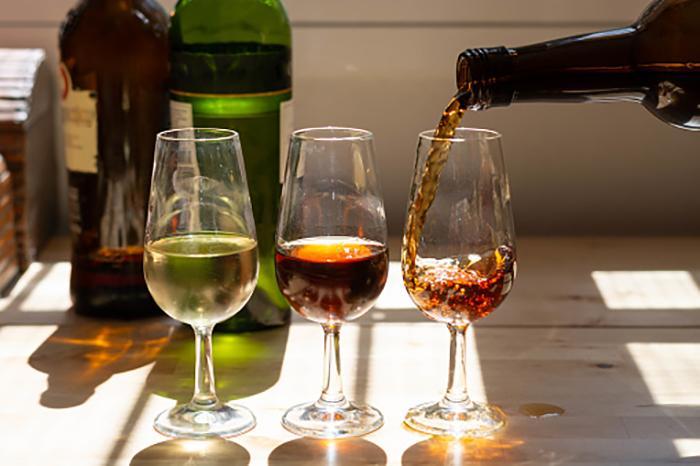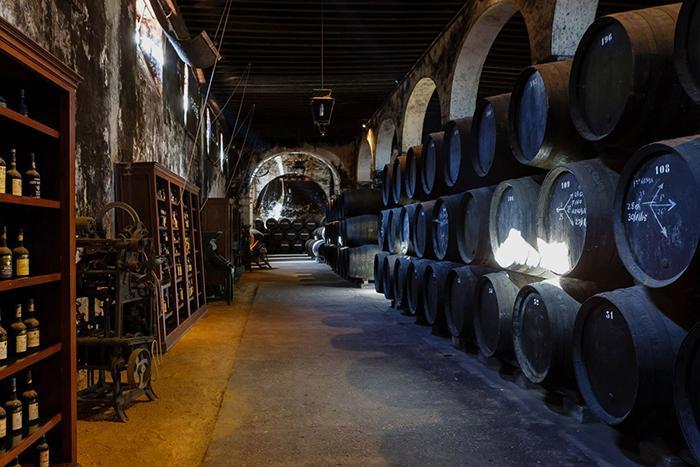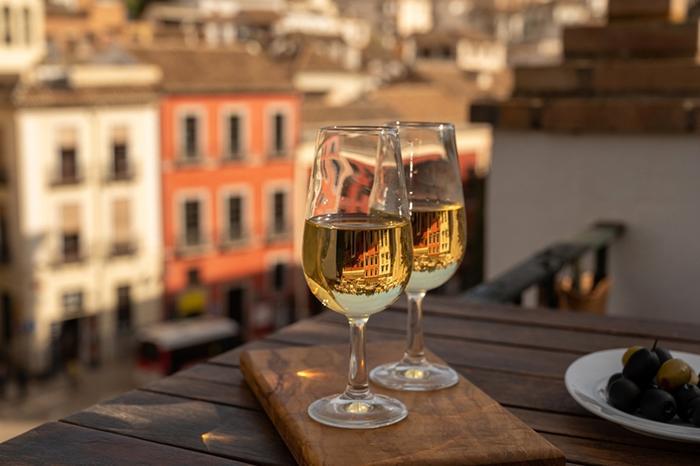Have you ever wondered what exactly Sherry is and why it’s favored by wine connoisseurs worldwide?
Originating from Andalusia, Spain, Sherry is a rich and complex fortified wine that has been cherished for centuries.
You Are Watching: What Is Sherry Updated 10/2024
This blog will dive deep into the essence of Sherry – its production, aging process, varying styles, and perfect ways to enjoy it.
Intrigued? Get ready to explore the world of this unique Spanish treasure.
Sherry: A Fortified Wine from Andalusia

Definition of Sherry
Sherry is a unique type of fortified wine hailing from the sunny Andalusian region in Spain.
Unlike regular wines, sherry involves a distinct production method called fortification that boosts its alcohol content.
High-proof brandy is added to the white grape wine after fermentation – a process giving Sherry an impressive alcohol range of 16-18 percent.
With roots ensconced deep within ancient civilizations such as Romans and Greeks, this age-old concoction enjoys widespread acclaim as one of the world’s oldest still reigning wines today.
Its rich heritage gets accentuated further by Jerez de la Frontera city’s unmatched terroir boasting chalky soil and Mediterranean Sea-influenced warm climate contributing to its nuanced flavors, making Sherry much more than just your average dessert sipping option!
Origin of Sherry
Sherry has a fascinating origin that dates back to ancient civilizations. This fortified wine traces its roots to the Andalusia region in Spain, specifically the city of Jerez de la Frontera.
Situated in the southwestern corner of Spain, this area is known as the Sherry Triangle and is renowned for producing this unique beverage.
Made from white grapes grown in these sun-drenched vineyards, Sherry has a long history that can be traced back to the Romans and Greeks.
The production process of Sherry involves fortification, which means adding high-proof brandy after fermentation to increase its alcohol content.
This traditional method adds depth and character to the wine and contributes to its distinct flavor profile.
Production and Aging Process of Sherry

Sherry is produced using a unique aging process known as the solera system, where young wines are blended with older ones in stacked barrels called criaderas to achieve a consistent flavor profile over time.
Grapes used in Sherry production
Sherry is made using a variety of white grapes, each contributing to the unique characteristics of the final wine.
The following grape varieties are commonly used in Sherry production:
- Palomino: This is the most widely planted grape variety for Sherry production and accounts for the majority of the region’s vineyards. It produces a light-colored and dry style of Sherry, with crisp acidity and subtle flavors.
- Pedro Ximénez (PX): This grape variety is used primarily to make sweet Sherries. The grapes are dried in the sun after harvest, concentrating their sugars and flavors. The resulting wine is rich, sweet, and often described as tasting like raisins or dried fruit.
- Moscatel: Another grape variety used for making sweet Sherries, Moscatel lends its floral and aromatic qualities to the final wine. It adds a perfumed note to Sherry, with flavors of orange blossom, musk, and honey.
- Palomino Fino: This specific clone of Palomino grape produces wines with higher acidity levels and lower alcohol content compared to other clones. It is often used in the production of fino-style Sherries.
- Muscat of Alexandria: Also known as Moscatel de Alejandria or simply Muscat, this grape variety is sometimes blended with other grapes to add complexity and aromatic character to certain styles of Sherry.
Fermentation and fortification
Sherry undergoes a unique fermentation and fortification process that contributes to its distinct flavor profile.
After the grapes are harvested, they go through the initial fermentation stage where yeast converts the sugars into alcohol.
However, unlike regular wines, sherry is then fortified with high-proof brandy, which increases its alcohol content.
This fortification process not only raises the alcohol percentage of the wine but also helps in stabilizing it and preventing spoilage.
By adding the brandy to the partially fermented wine, this halts further fermentation and leaves behind residual sugar levels that vary depending on the style of sherry being produced.
Once fortified, sherry goes through an aging process that adds depth and complexity to its taste. Whether it be fino aged under a layer of flor or oloroso exposed to oxygen contact throughout aging – each method gives rise to different styles of sherry with their own unique characteristics.
Aging methods
Sherry is known for its unique aging process called the solera system. This method involves a series of barrels stacked on top of each other, with the oldest wine in the bottom barrel and the youngest in the top.
As new wine is added to the system, it fills up the barrels from above, blending with older wines through a process known as fractional blending.
The solera system allows Sherry to develop a consistent flavor profile over time.
older wines impart their complexity and depth to the younger ones, creating a harmonious blend. This gradual blending also ensures that no single vintage dominates the final product.
Different Styles of Sherry

Dry Sherry
Dry Sherry is a type of fortified wine that offers a unique and sophisticated drinking experience.
Made using the solera system, this style of sherry undergoes a carefully controlled aging process that gives it its distinctive dry flavor profile.
With varieties like Fino, Manzanilla, Amontillado, Oloroso, and Palo Cortado, each offering its own character and complexity, there’s something to suit every palate.
Fino and Manzanilla are aged under a layer of yeast called flor, which creates a protective barrier between the wine and the air.
This aging method leads to delicate flavors of almonds and green apples with a crisp finish.
On the other hand, Amontillado sherry starts off as Fino but continues aging without flor exposure. This results in an amber-colored wine with nutty aromas and hints of caramel.
For those who prefer richer flavors, Oloroso sherry is aged without any flor influence. It develops into a full-bodied wine with intense notes of dried fruits, nuts, and spices.
Finally, Palo Cortado is considered rare as it occurs when Fino wine mysteriously evolves into an Oloroso-like style during aging.
Fino
Fino is one of the distinct styles of sherry, known for its light and delicate flavor profile. It is aged under a layer of yeast called flor, which forms naturally on the surface of the wine during fermentation.
This unique aging process gives Fino sherry its characteristic crispness and nutty aroma. With an alcohol content ranging from 15 to 17 percent, Fino sherry pairs exceptionally well with seafood and tapas.
Whether it’s enjoying a chilled glass on a warm summer day or using it as an ingredient in your favorite cocktail recipes, Fino sherry offers a refreshing and versatile drinking experience.
So raise your glass and savor the flavors of this exquisite fortified wine from Andalusia, Spain.
Manzanilla
Manzanilla is a unique style of sherry that originates from the coastal town of Sanlúcar de Barrameda in Andalusia, Spain.
This particular type of fortified wine is often referred to as the “fino of the sea” because it shares many similarities with fino sherry.
Manzanilla undergoes aging under a layer of yeast called flor, just like fino, which gives it a light and delicate flavor profile.
What sets manzanilla apart is its distinctive maritime influence. The winemaking process takes place in bodegas located near the Atlantic coast, where cool ocean breezes and high humidity contribute to the formation of a thicker and more robust layer of flor on top of the maturing wine barrels.
This results in an even fresher taste with pronounced saline notes.
Manzanilla pairs exceptionally well with seafood due to its briny character. Its crisp acidity and subtle nutty undertones complement dishes like oysters, clams, and shrimp perfectly.
It’s also enjoyed as an excellent apéritif or refreshing summer drink due to its lighter body and fresh flavors.
Amontillado
Amontillado is a type of dry sherry that falls somewhere between fino and oloroso in terms of its aging process.
It starts off like a fino, with the wine aged under flor to develop the light and delicate flavors.
However, unlike finos, amontillados are then exposed to oxygen for further aging, resulting in a richer and more complex taste profile.
Amontillado sherry typically has a golden color and exhibits nutty aromas with hints of caramel and dried fruit.
Its smooth texture and balanced acidity make it an excellent choice for pairing with cured meats, mature cheeses, or even roasted vegetables.
Whether you’re new to the world of sherry or looking for something different from your usual drink choices, amontillado offers a unique experience that’s definitely worth exploring.
Oloroso
Oloroso is a style of sherry that offers a bold and robust flavor profile. Unlike fino and manzanilla, which are aged under a layer of yeast called flor, oloroso sherry is aged in contact with oxygen.
This oxidative aging process gives the wine its distinctive dark color and rich, nutty flavors.
Oloroso sherry has higher alcohol content compared to other styles, typically ranging from 18-20 percent.
Read More : What Is Scotch Made From Updated 10/2024
With its intense aromas and complex taste, it’s no wonder that this fortified wine is often enjoyed as a sipping drink or paired with strong cheeses and hearty dishes.
Whether you’re exploring the world of sherry or looking for something adventurous to try, oloroso sherry is definitely worth experiencing.
Palo Cortado
Palo Cortado is a unique and highly prized style of sherry that falls somewhere between the crispness of an amontillado and the richness of an oloroso.
This rare variety occurs when a fino or amontillado sherry, intended to develop under a layer of flor, mysteriously loses its protective yeast layer and begins to oxidize like an oloroso.
The result is a remarkable wine with complex flavors and aromas that combine the nutty characteristics of an oloroso with the delicate freshness of a fino.
Palo Cortado has attracted attention among sherry enthusiasts for its exceptional quality and limited availability, making it a must-try for any lovers of fortified wines.
Sweet Sherry and other variations
Sweet sherry is a delicious variation of this fortified wine, perfect for those with a sweet tooth. Made from grapes that have a higher sugar content, these sherries offer a luscious and indulgent taste experience.
One popular type of sweet sherry is Pedro Ximénez (PX), known for its rich and syrupy consistency.
PX sherry is made by drying the grapes in the sun before fermentation, which concentrates their sugars and intensifies the flavors.
This results in a dessert wine that boasts notes of raisins, toffee, and caramel, making it an excellent companion to chocolate-based desserts or creamy cheeses.
Another variation worth mentioning is cream sherry, which combines sweet grape must with older Oloroso or Amontillado sherries to create a smooth and velvety texture with hints of dried fruits and nuts.
Apart from these sweet variations, there are also other unique types of sherry worth exploring. Pale Cream Sherry offers light sweetness along with refreshing acidity, making it ideal for sipping on warm summer days.
Moscatel sherry has floral aromas and honeyed flavors due to the use of muscat grapes during production.
How to Enjoy Sherry

Pairing Sherry with food
- Sherry is a versatile wine that can be paired with a variety of foods, making it a great choice for those who enjoy exploring different flavors and combinations.
- Fino and manzanilla sherry have a delicate and crisp taste that pairs well with seafood dishes such as oysters, clams, and shrimp. The tangy and salty notes of the wine complement the freshness of the seafood.
- For richer and more flavorful dishes like cured meats, aged cheeses, and nuts, oloroso sherry is an excellent choice. Its nutty and caramelized flavors enhance the savory qualities of these foods.
- The sweetness of sweet sherry makes it a perfect match for desserts such as chocolate truffles, fruit tarts, and creamy cakes. The rich and luscious taste of the wine adds depth to the sweetness of the dessert.
- When pairing sherry with food, it’s important to consider the intensity of both the wine and the dish. Lighter styles of sherry should be paired with delicate flavors, while bolder sherry varieties can handle more robust dishes.
- To get started with sherry pairing, try serving fino or manzanilla sherry as an aperitif alongside some marinated olives or almonds. This combination will awaken your palate before enjoying a meal.
- When serving oloroso or sweet sherry with dessert, consider complementing their flavors with rich and decadent treats like dark chocolate mousse or crème brûlée.
Serving temperature and glassware
Sherry is best enjoyed when served at the right temperature and in appropriate glassware.
Here’s what you need to know:
- Serve chilled: Sherry is typically served chilled, but the specific temperature can vary depending on the style of sherry. For lighter and drier sherries like fino and manzanilla, it is recommended to serve them between 7-9 degrees Celsius (45-48 degrees Fahrenheit). This helps preserve their delicate flavors and aromas.
- Use a copita or a tulip-shaped glass: When it comes to glassware, traditional copita glasses are often used for tasting and sipping sherry. These glasses have a narrow rim that concentrates the aromas of the wine, allowing you to fully experience its nuances. Alternatively, tulip-shaped glasses can also be used as they provide similar benefits.
- Avoid using large wine glasses: While wine glasses can work in a pinch, it’s best to avoid using large bowls or wide-rimmed glasses for sherry. These types of glasses don’t concentrate the aromas as well as copita or tulip-shaped glasses do.
- Experiment with different serving temperatures: Depending on personal preference and the specific style of sherry you’re drinking, you may want to experiment with different serving temperatures to find what suits your taste best. Some people prefer slightly warmer temperatures for certain styles, such as oloroso sherries, which can be served between 13-15 degrees Celsius (55-59 degrees Fahrenheit) to enhance their bold flavors.
- Don’t forget dessert sherry: If you’re enjoying sweeter styles of sherry like Pedro Ximénez or cream sherry, they are often served slightly colder than dry sherries – around 6-8 degrees Celsius (43-46 degrees Fahrenheit) – to balance their sweetness.
Popular Sherry cocktails and drinks
Here are a few popular recipes that you can try:
- Sherry Cobbler: This classic cocktail combines sherry with muddled fruit and a splash of soda water. It’s refreshing and perfect for warm summer days.
- Sherry Flip: A rich and creamy cocktail made with sherry, egg yolk, sugar, and nutmeg. It’s like a dessert in a glass.
- Adonis: This cocktail combines equal parts of sherry and sweet vermouth, garnished with an orange twist. It’s simple yet sophisticated.
- Bamboo: Mixing dry sherry with dry vermouth and adding a few dashes of bitters creates a balanced and aromatic cocktail called the Bamboo.
- Sherry Sour: Similar to the classic whiskey sour, this cocktail substitutes the whiskey with sherry for a unique twist on the original recipe.
Exploring the unique flavors of Sherry
Sherry offers a wide range of unique flavors that make it a fascinating wine to explore.
From the light and delicate profile of fino and manzanilla sherry, which is characterized by its crispness and nutty undertones, to the richer and more robust oloroso sherry with its deep amber color and complex aromas of dried fruits, there is something for everyone to enjoy.
The aging process plays a crucial role in developing these distinct flavors, whether it’s the protection from oxygen under a layer of yeast or the intentional exposure to oxygen for an oxidative style.
Sherry also boasts versatility as it can be enjoyed on its own, paired with various foods like tapas or cheese boards, incorporated into cocktails like the classic Sherry Cobbler or even used as an ingredient in cooking to add depth and complexity to dishes.
Sherry as a cooking ingredient
Sherry is not just a delightful drink on its own, but it can also add a unique depth of flavor to your cooking.
Its rich and complex taste makes it a versatile ingredient that can enhance both savory and sweet dishes.
Use dry sherry to deglaze pans when cooking meats or sautéing vegetables for added complexity. The sweetness of sweet sherry lends itself well to desserts, such as poaching fruit or creating decadent sauces like caramel or chocolate.
Sherry’s distinctive flavors make it an excellent addition to marinades, salad dressings, and even soups and stews.
So the next time you’re in the kitchen, consider reaching for a bottle of sherry to elevate your culinary creations with its delicious essence.
Conclusion
In conclusion, Sherry is a fascinating fortified wine with a rich history and unique flavors.
Whether you’re sipping it as an aperitif, pairing it with a delicious meal, or using it in your favorite recipes, Sherry offers a versatile and enjoyable drinking experience.
Explore the different styles and discover why this Spanish gem has stood the test of time. Cheers to the world of Sherry!
Sources: https://chesbrewco.com
Category: Wine










